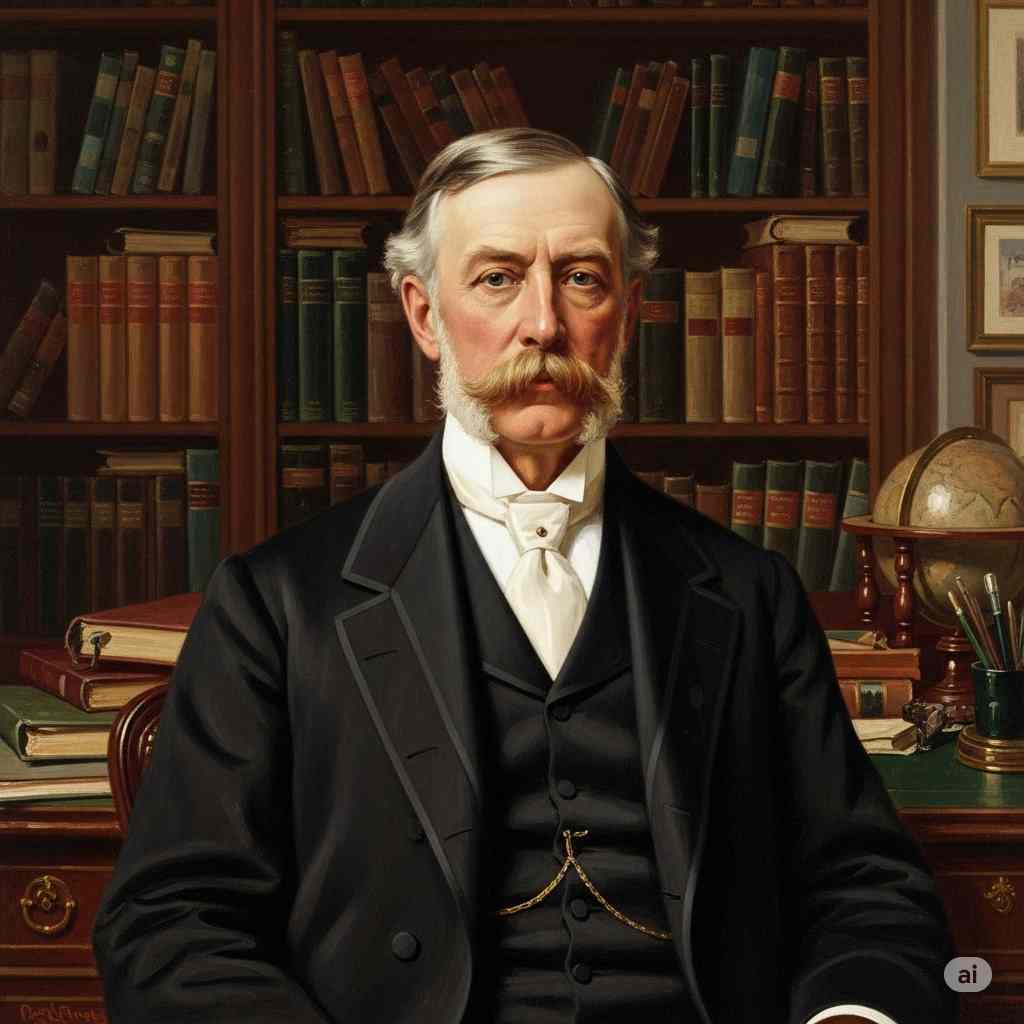I Am Standing Upon the Seashore
Henry Van Dyke
1852 to 1933

I am standing upon the seashore.
A ship at my side spreads her white
sails to the morning breeze and starts
for the blue ocean.
She is an object of beauty and strength.
I stand and watch her until at length
she hangs like a speck of white cloud
just where the sea and sky come
to mingle with each other.
Then, someone at my side says;
"There, she is gone!"
"Gone where?"
Gone from my sight. That is all.
She is just as large in mast and hull
and spar as she was when she left my side
and she is just as able to bear her
load of living freight to her destined port.
Her diminished size is in me, not in her.
And just at the moment when someone
at my side says, "There, she is gone!"
There are other eyes watching her coming,
and other voices ready to take up the glad shout;
"Here she comes!"
And that is dying.
Henry Van Dyke's I Am Standing Upon the Seashore
Introduction
Henry Van Dyke's poem "I Am Standing Upon the Seashore" is a profound meditation on the nature of death and the human experience of loss. Through the extended metaphor of a ship's journey, Van Dyke crafts a poignant and ultimately hopeful reflection on the transition from life to death. This essay will explore the poem's structure, imagery, themes, and philosophical underpinnings, demonstrating how Van Dyke's masterful use of language and symbolism creates a work that resonates deeply with readers, offering comfort and a new perspective on mortality.
Structure and Form
The poem is structured as a single stanza, comprising 26 lines of free verse. This unbroken form mirrors the continuous nature of the narrator's observation and reflection, creating a sense of uninterrupted contemplation. The lack of a rigid metrical structure allows Van Dyke to adapt the rhythm of the lines to the emotional content, with shorter lines often coinciding with moments of heightened impact or realization.
The poem's progression can be divided into three main sections: the initial observation of the ship (lines 1-9), the dialogue and reflection on its disappearance (lines 10-21), and the final revelation about the nature of death (lines 22-26). This tripartite structure mirrors the stages of grief and acceptance, guiding the reader through the emotional journey of the narrator.
Imagery and Symbolism
Central to the poem is the extended metaphor of the ship's journey as a representation of the passage from life to death. Van Dyke's choice of a ship is particularly apt, drawing on a rich tradition of nautical imagery in literature to symbolize life's journey and the transition to the afterlife.
The opening lines establish a serene and beautiful scene: "A ship at my side spreads her white / sails to the morning breeze and starts / for the blue ocean." This imagery evokes a sense of hope, possibility, and the natural order of things. The ship is described as "an object of beauty and strength," suggesting the vitality and dignity of life.
As the ship recedes from view, Van Dyke employs a subtle but effective shift in imagery: "she hangs like a speck of white cloud / just where the sea and sky come / to mingle with each other." This transformation from a tangible vessel to an ethereal speck blurs the boundaries between the physical and spiritual realms, foreshadowing the poem's ultimate message about the nature of death.
Perspective and Point of View
A crucial aspect of the poem is its manipulation of perspective. The narrator begins as an observer on the shore, watching the ship depart. This viewpoint is then challenged by the dialogue introduced midway through the poem: "Then, someone at my side says; / 'There, she is gone!'" This interjection serves multiple purposes. It breaks the solitary reflection of the narrator, introducing a common perception of death as an ending or disappearance.
The narrator's response, "Gone where?" followed by the assertion "Gone from my sight. That is all," marks a pivotal moment in the poem. It challenges the finality implied by the onlooker's statement and introduces the poem's central philosophical argument: that death is a matter of perspective rather than an absolute end.
Themes and Philosophical Implications
Van Dyke's poem grapples with several interconnected themes, chief among them the nature of death, the limitations of human perception, and the continuity of existence beyond our immediate experience.
The poem presents death not as an end, but as a transition—a passing from one state of being to another, from one realm of perception to the next. This is powerfully conveyed in the lines: "She is just as large in mast and hull / and spar as she was when she left my side / and she is just as able to bear her / load of living freight to her destined port." Here, Van Dyke asserts that the essential nature of the departed remains unchanged; it is only our ability to perceive them that has altered.
This idea is further reinforced by the statement "Her diminished size is in me, not in her." This line encapsulates a profound philosophical insight: that our perception of reality is limited and subjective. What we perceive as the "end" of life is merely the limit of our ability to observe and interact with the departed.
The poem also touches on themes of continuity and the interconnectedness of all things. The image of the ship passing from the sight of those on one shore only to be greeted by those on another emphasizes the cyclical nature of existence and the idea that life continues beyond our individual experience of it.
Language and Tone
Van Dyke's use of language is deceptively simple yet deeply evocative. The poem employs mostly straightforward, accessible vocabulary, but achieves its emotional and philosophical depth through careful word choice and phrasing.
The tone of the poem shifts subtly as it progresses. It begins with a sense of quiet observation, moves through a moment of apparent loss, and concludes with a tone of revelation and reassurance. This progression is achieved through both the content of the lines and their rhythmic structure. The final lines, with their short, declarative statements—"And that is dying."—carry a weight of finality and acceptance that resolves the emotional tension built throughout the poem.
Cultural and Literary Context
"I Am Standing Upon the Seashore" sits within a rich tradition of poems dealing with death and the afterlife. Its approach bears similarities to Walt Whitman's "Crossing Brooklyn Ferry" in its exploration of continuity beyond individual experience, and to Emily Dickinson's more compressed meditations on mortality.
The poem's hopeful perspective on death also reflects broader cultural and religious influences, particularly Christian concepts of the afterlife and the soul's journey. However, Van Dyke's treatment of the subject is sufficiently universal to resonate with a wide range of philosophical and spiritual viewpoints.
Impact and Relevance
Since its publication, "I Am Standing Upon the Seashore" has found a place in popular culture as a source of comfort for those dealing with loss. Its accessible language and powerful imagery make it a frequently chosen text for funerals and memorial services.
The poem's enduring appeal lies in its ability to reframe the experience of loss in a way that offers solace without denying the reality of grief. By presenting death as a transition rather than an ending, Van Dyke provides a perspective that allows for both mourning and hope.
Conclusion
Henry Van Dyke's "I Am Standing Upon the Seashore" is a masterful exploration of one of humanity's most profound and universal experiences. Through its carefully constructed imagery, thoughtful manipulation of perspective, and deep philosophical insights, the poem offers readers a new way of understanding and coming to terms with mortality.
The power of the poem lies not just in its comforting message, but in the way it encourages active engagement with the concept of death. By inviting readers to imagine themselves as both the observer on the shore and the welcoming voices on the distant coast, Van Dyke prompts a reconsideration of our place in the grand continuum of existence.
In an age where discussions of death are often avoided or sanitized, "I Am Standing Upon the Seashore" stands as a testament to the power of poetry to address life's most challenging themes with grace, wisdom, and profound humanity. It reminds us that in contemplating death, we may find a deeper appreciation for life and our connections to one another.
This text was generated by AI and is for reference only. Learn more
Want to join the discussion? Reopen or create a unique username to comment. No personal details required!



Comments
No comments yet. Be the first to comment!